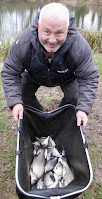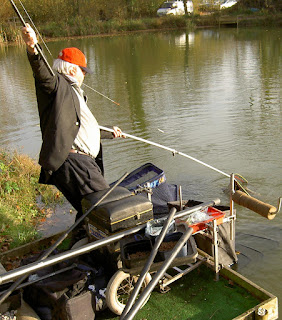I monotonously mention the Ronnie Rig in my Bloggs, been asked many times "what's a Ronnie Rig". So here goes.
I have showed a few anglers this rig, some have said it's too fiddly or too complicated for them, some have adapted it to suit their way. The most important aspect of this rig is to minimise the amount of feed maximising the the number of fish caught. I have had 100 lb of silvers on less than 1 pint of casters. So give it a try.
History:
Why have I named it the
Ronnie Rig? It originates from local angling legend and good friend Colin
Golding (RIP). Colin fished and ran the over 55’s at Hunstrete for many years. His
only bait for most of the year was 6 mm expander, purchasing a sack every year using
them for both hook bait and feeding, his target was Carp and Skimmers. However, as with many commercial fisheries there
is lots of small 2 – 3 oz Roach. These small Roach would nick his hooked
expanders frustrating him to regularly hear him shout “Fucking Ronnie’s”, never failed to amuse me. I had been fishing this rig for about 25 years and subsequently
name it “The Ronnie Rig” about 17 years ago.
Top Sets:
The rig is “to hand” using
the top sets from my Drennan poles. I use top sets a lot, hence preference for long ones
which is the primary reason for choosing the Drennan Acolyte pole range. I have
all three Acolyte poles. Some of their top sets comprise two pieces – called “double top two’s”. This enables me to fish the rig short or long. The long rig
is usually fished out in front in the deeper water and the shortened top set
primarily down the edge or out in front shallow without change of depth.
Elastics:
Over the years I have tried
various elastics, but have settled on the Drennan Power pull Green rated 9 – 11
which is reasonably priced and does two long top sets. When the long gets worn at
either the puller or connector it then recycles to the short top sets. I like a
bit of a “snotty nose” at the puller giving lighter strike. This elastic may
appear heavy for Roach fishing, however, light elastics tend to bounce when
swinging, a slight difference in fish weight can be hard to judge how far
to lift to hand and can catch you out, occasionally hitting the keepnet. Then, there is the likelihood of hooking a Carp which is always useful to land.
Rig Attachment:
I have recently changed my
preferred elastic attachment to that previously explained in the following blog:-
https://silverfoxangling.blogspot.com/2023/11/monday-20112023-elastic-connection-rig.html
Rig Line:
My preference is 0.16 diameter
GLine. Again heavy you may think, but it helps with Carp proofing and rig line
longevity. Now for a bit of stress engineering, I use a single over hand knot
for both attachments to the elastic and hook length. This provides the smallest
stress concentration factor and allows better transfer of stresses from elastic to the
line, and line to hook length with reduced likelihood of breaking at the
knot preventing rig lose. However, all my hook length knots are figure of eights providing a higher
stress concentration factor with the anticipation of the hook length being the weakest link.
Floats:
Again over the years I have
tried allsorts of floats, sometimes forced to change due to them becoming
obsolete. However, they all had wire stems for stability, roundish body to help
presentation in windy conditions and about 3.5 gram. The latest float and so far the best is the
Ryan Jordan’s Mini Lifters which has line through body. Ryan has made some specials for me mostly 0.3 to
0.4 gram, some with Niti wire through body, some with Carbon through body and some
with wire stems and carbon tips. All these floats have super sensitivity with
excellent visibility (I named them sensibilities). They are very robust floats. Shotting the through wires is
not as frustrating as some through wire such Sensas Pencil floats. I use the
wire through’s when it’s hard fishing primarily on the short top set. It’s
amazing how many indications you get with all these floats, there is some
learning in reading the indications and when to strike. Certainly lets you know
if there are any fish around. No indications then unlikely that there’s fish anywhere near the bait. My preference is yellow tips.
Shotting:
On some occasions I’m speed
fishing catching small fish, the last thing you want is for shot to fall off or
start moving around on the line causing delays. I therefore use round shot,
after all you never see a submarine with a flat Bow. Ballabeni shot is my
choice in size 11’s which fits the 0.16 diameter line comfortably.
I try to avoid smaller shot but sometimes it’s necessary to use size 12 which I put as the dropper. This Shotting pattern was derived from a well
know angler Ray Mumford back 45 or so years. Ray often fished the Bristol Avon in search of the bigger matches and would call me late at night for river status etc...sometimes when in bed! Ray had been to France
fishing, primarily to get some inside information on the new method just
taking off here in the UK
- pole fishing! He came back with what he called the Logarithmic Shotting pattern
(some anglers having recently utilised a similar shotting named it the “Taper Pattern”). I used
it on the river a few times on the long whip and Stick float but mostly on the Waggler,
but the pattern came into it’s own on Commercial and still venues where I discovered
its true value. It was really effective on the Gloucester Canal.
Then there is the important back shot. Again a number 11 shot which starts off at approximately 12 inches from the tip of the float. I can adjust the visibility and sensitivity of the float either up or down by moving the shot either further up the line to rise the float or nearer the float to lower it. The moving of the shot is regularly used throughout the match dependant on the cooperation of the Ronnie's.
I have a bit of a reputation
for being sparing with the feed – told I starve the fish on the hook. All not
quite as it appears. The floats take about 10 number 11 shot and simulate
feeding caster with the shot making the similar noise hitting the water to casters and falling at about the same rate, giving the effect of feeding 10 casters every put in, spread along the
rigs length, enabling catching fish at all depths through an arc. Think 3D fishing. I try to loose feed along the arc line mimicking the shot.
Shotting pattern can be easily adjusted to weigh down or weigh up.
I remember Coilin Golding coming back from the world Championship's in France and his first comment to me was - "Can't understand the French they put the majority of their shot and the top and very little at the bottom". Which back then was opposite to our way of fishing.
Hooks and hook Lengths:
I use Tubertini 808 hooks
due to the weight to strength ratio and particular like the wide gape, primarily sizes 18 to
20. Line again is GLine 0.14 diameter for “all in” matches, switching to 0.1
diameter for silvers only matches as Carp protection. Seven turns is ample for hook to line blood knot. I use 0.14 diameter as think it more important to have a stiff line rather than small diameter particularly
of on commercial fisheries. Always use 6 inch hook lengths, if using 0.14 diameter then bottom shot can safely moved to the hook length if required.
I will say if you have a preference to a
specific hook and line type which you have faith in then stick with it.
Application:
Rigs are initially set to dead depth and sometimes increase depth or shallow up as the match progresses. The session is usually kicked off by feeding a small ball of GB (whatever is your favourite/manufacture) laced with caster on top of the float
which in my case is top set plus one barrel for the long rig and just a top set
for the short rig. I start fishing over this with weight down which is more
suitable for Skimmers. During the next few minutes I can tell what’s feeding in
the peg. I usually start then loose feeding casters or maggot as appropriate, topping up with the GB as required. I try never
to use a landing net as I’m sure the more the fish are being played and being
chased by a landing net the more likelihood it will spook other fish near by. Will drop a few ounces swinging, but still worth it. If Ronnie’s becomes the
primary target then I switch to the shot weight up, but this dependant on how they
are feeding. Casting can vary to suit, can slap it down or lay it lighter over
head or under hand for an even gentler lay in.
Species:
This rig is specifically for
Roach (Ronnie’s), Rudd, Perch and the occasional Skimmer. The "looking up fish" Carp and F1’s don’t particularly
like the falling arc presentation the rig provides.



























